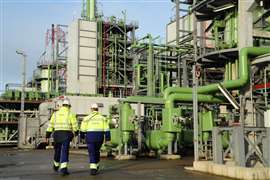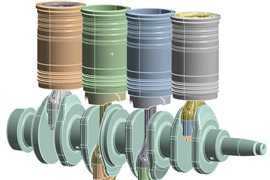Read this article in 中文 Français Deutsch Italiano Português Español
3 Reasons HVO was 2023 Newsmaker of the Year
01 January 2024
Hydrotreated vegetable oil earned Diesel Progress’ long-time annual recognition. Here’s a few of the reasons why.
Since 1997, Diesel Progress — rebranded this month as Power Progress — has been giving its Newsmaker of the Year award to the person, company, product, technology, trend or issue that generated the most news and discussion over the calendar year. For 2023, the distinction went to hydrotreated vegetable oil (HVO), which is often referred to as renewable diesel fuel.
In a world containing numerous alternative energy supplies for equipment and vehicles, what set HVO apart in 2023?
1. HVO Has Significant Potential as a Sustainable Fuel
 Sustainable fuel maker Neste's refinery in Rotterdam, Netherlands, where the company manufactures HVO. The company said the refinery's 1.4 million ton capacity for renewable products in Rotterdam is the largest in Europe. In addition, Neste also has refineries in Finland, Singapore and a joint operation with Marathon in Martinez, Calif., which Neste said makes it the only global provider of renewable diesel, sustainable aviation fuel and renewable feedstock for polymers and chemicals with a production footprint on three continents. (Photo: Neste Oyj)
Sustainable fuel maker Neste's refinery in Rotterdam, Netherlands, where the company manufactures HVO. The company said the refinery's 1.4 million ton capacity for renewable products in Rotterdam is the largest in Europe. In addition, Neste also has refineries in Finland, Singapore and a joint operation with Marathon in Martinez, Calif., which Neste said makes it the only global provider of renewable diesel, sustainable aviation fuel and renewable feedstock for polymers and chemicals with a production footprint on three continents. (Photo: Neste Oyj)
Julian Buckley, editor of Power Progress International, was part of the team that chose HVO as Newsmaker of the Year. He said sustainability has long been a driving force behind new power technology, with sustainable fuel having unique potential to deliver some big wins in terms of environmental performance.
“That prompted more thought about the sustainable fuel market and the various players, including biodiesel, biomethane, hydrogen and HVO,” he said. “While most of these require some considerable infrastructure development to support end-user delivery, HVO can use existing supply lines, and it has a captive and local raw material source that helps maintain the fuel’s sustainability credentials.”
Buckley said those factors, combined with its compatibility with existing engine technologies, make HVO the current standout performer in sustainable fuels.
2. HVO is a Drop-In Replacement for Diesel Fuel
HVO’s compatibility with today’s engines is due to the refining process used to make it, which is similar to that which is applied to crude oil. As such, HVO is a hydrocarbon like diesel fuel and is chemically so similar to diesel that it is considered a drop-in replacement, meaning a vehicle or piece of equipment with a diesel engine can run on either petroleum diesel or HVO without any modification.
“There are no molecules in the HVO that you don’t find in diesel fuel, so it is chemically very similar, except that it’s missing some of the nasty stuff that doesn’t burn cleanly,” said Markku Honkanen, head of technical services for renewable fuel maker Neste, based in Espoo, Finland.
Like diesel, HVO meets ASTM D975 specifications. It also complies with EN 15940 specifications for paraffinic diesel fuels and Fuel Quality Directive 2009/30/EC.
Honkanen added that HVO use does not require a particular emissions certification. “There are some benefits in the combustion so that if you have an old engine without any aftertreatment systems at all — say some nonroad application where they are not yet needed — you get some benefit on the tailpipe emissions,” he said. “If you have a modern engine with the catalyst and the SCR and the DPF and all the bells and whistles, you see the same tailpipe emission [as diesel] pretty much, although you’d stress the aftertreatment system less.”
While there are hundreds of stock engine models on the market theoretically capable of running on HVO today, it is important to note that a manufacturer could require its engines to run exclusively on petroleum diesel fuel as a condition of its warranty. Engine makers that have publicly announced one or more series of engines approved for HVO include AGCO, Caterpillar, Cummins, Deutz, FPT Industrial, Kubota, MAN, Perkins, Rolls-Royce and Scania.
3. HVO Offers Some Advantages Over Biodiesel
HVO and biodiesel are not the same. They are manufactured via different methods. This makes biodiesel chemically different than petroleum diesel with different properties. For example, at 100 percent concentration — referred to as B100, or biodiesel that has not been blended with petroleum diesel — biodiesel acts as a solvent, which might frustrate operators if they are not prepared for its effects.
“When biodiesel first hit the scene about 20 years ago, a lot of operators had issues with filters plugging and other stuff,” said Matt Leuck, technical services manager for Neste. “Because of the chemistry of biodiesel — it will grab water and turn it into a solvent, which is making it try to clean out the fuel tanks and lines that they had been running for a long time.” The accelerated filter changes caused some frustration, Leuck said, adding that HVO does not attract water and thus does not have a similar effect.
That solvent property of biodiesel has other drawbacks, as well. “Not all the materials used in the fuel systems, in the logistics chain or in the vehicles are compatible with B100,” Honkanen said.
Leuck added that the D975 specification in the U.S. addressed this particular property by requiring biodiesel to be blended with petroleum diesel at a concentration of only 5 percent — referred to as B5 diesel. “Engine manufacturers were not comfortable with higher than that [concentration],” he said. “Over time, there’s now up to a B20 spec, and the engine manufacturers have nearly all accepted B20, as well.”
In a July 2022 article on its website, “Hydrotreated Vegetable Oil (HVO) Explained,” Cummins brand journalist Catherine Morgenstern said that HVO can be blended with petroleum diesel — in any proportion.
Honkanen said that biodiesel storage is also an issue. “The European quality standard says that the mark is six months to be used, and there is no such sharp limitation for HVO. [HVO] is very stable in that sense.” On its website, UK fuel tank maker Tuffa Tanks said HVO can be stored for about 10 years.
According to Leuck, one of the biggest advantages to using HVO over biodiesel is a result of its production process. “We can basically choose the cloud point of the fuel that we want to make. So whether it’s a summer fuel for the U.S. or a winter [fuel] for the Nordics and other places, we can engineer in some of these physical properties, whereas the biodiesel production process doesn’t allow them to do that.”
POWER SOURCING GUIDE
The trusted reference and buyer’s guide for 83 years
The original “desktop search engine,” guiding nearly 10,000 users in more than 90 countries it is the primary reference for specifications and details on all the components that go into engine systems.
Visit Now
STAY CONNECTED




Receive the information you need when you need it through our world-leading magazines, newsletters and daily briefings.
CONNECT WITH THE TEAM













